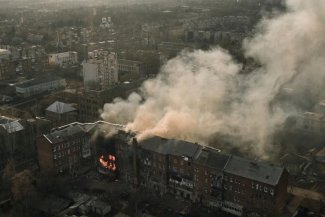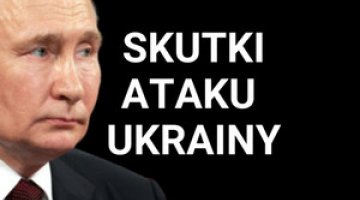Russians approach Bakhmut. 291st day of the war

Russian forces have reached the southern and eastern borders of Bakhmut, which was about to be completely ruined due to permanent shelling. According to some sources, fighting occurs in the industrial area in the city’s eastern part. Ukrainian units have repulsed further offensive attempts to the northeast of Bakhmut. They are also expected to hold back the enemy east and north of Siversk, west of Horlivka, north of Avdiivka and west of Donetsk, where the central fighting area is Marinka. Both sides were to undertake offensive operations on the border of the Kharkiv and Luhansk oblasts, north and west of Kreminna and in the western part of the Donetsk Oblast but had no apparent success with them. The Russians were to reinforce their grouping in the Svatove area, while the Ukrainians were to reinforce their grouping in Bakhmut.
On 10 December, the invaders launched a drone attack on the Odesa Oblast’s energy infrastructure, disrupting loading at Odesa and Pivdennyi ports and its reduction at Chornomorsk. By 12 December, loading had been restored at the latter two, while the first still needed to be fixed. Defenders reported that 10 of the 15 Shahed-136/131 drones used by the aggressor had been shot down.
The targets of the Russian missile attacks were Kostiantynivka in the Donetsk Oblast, Kupiansk, Mykolaiv and the Zaporizhzhia region. Kharkiv and Nikopol and their surroundings and the Ochakiv region remain under permanent artillery fire. In addition, Russian artillery and aviation continued to strike Ukrainian army positions and facilities along the contact line and in border areas. In turn, Melitopol and Svatove were the main targets of Ukrainian shelling. According to some sources, there was a Ukrainian diversion in Crimea on 10 December (in Dzhankoi, Sevastopol and Simferopol).
The Ukrainian army was to receive 155 mm FH70 towed howitzers from Italy, along with Iveco Astra tractors. The US Department of Defense announced another $275 million package of military aid to Ukraine, including missiles for HIMARS launchers and 80,000 rounds of 155 mm artillery ammunition. On the recommendation of the US, spare parts for T-72 tanks are to be provided by Morocco. Germany announced the handover of 16 Biber armoured bridgelayers and five Dachs armoured engineer vehicles. Berlin also announced opening a repair base in Košice, Slovakia, to service arms and military equipment being transferred to Ukraine. According to unofficial information, the Ukrainian army is expected to receive two modern German 35 mm Skynex anti-aircraft guns in 2024. Ammunition, including heavy calibres, is to be supplied by Slovakia, and ammunition and light weapons by Bulgaria.
On 11 December, Ukrainian Defence Minister Oleksii Reznikov announced that armed forces activity declined due to bad weather conditions. He added that counter-attacks would continue once the frosts arrived and the ground hardened.
On 11 December, Prime Minister Denys Shmyhal acknowledged that all thermal and hydroelectric power plants had been damaged after eight waves of Russian missile attacks, and 40% of high-voltage grid facilities remain damaged to varying degrees. A significant power shortage persists in the system. The government has earmarked more than 5 billion hryvnias (approximately $135 million) to reconstruct the power grids. The day before, President Volodymyr Zelensky stated that more than 1.5 million people were without electricity after the Odesa air raid (a day later, the number dropped to 300,000), and only critical infrastructure remained connected. Most power outages occur in the Lviv, Vinnytsia, Kyiv, Ternopil, Sumy, Zakarpattia, Zhytomyr and Khmelnytskyi oblasts, as well as Kyiv. On 8 December, the State Special Communications Service reported that in the event of a nationwide blackout, mobile communications operators could guarantee network operation for at least three days. TV stations and five radio stations are expected to maintain similar capacity. According to the authorities, 82% of mobile base stations are currently operational in Ukraine.
A campaign of intimidation against the staff of Ukrainian diplomatic missions is underway. On 7 December, Foreign Minister Dmytro Kuleba said diplomats were receiving threatening mail. So far, 31 such cases have been reported in 15 countries – Austria (1), Vatican City (1), Denmark (1), Spain (5), Italy (4), Kazakhstan (1), Netherlands (1), Poland (6), Portugal (2), Romania (2), USA (1), Hungary (2), France (1), Croatia (1) and the Czech Republic (2). All envelopes show the same sender address – a Tesla car showroom in the German city of Sindelfingen. The ministry stressed that this terror campaign is one of the most unprecedented in the world and aimed to discredit Ukrainian diplomats.
The Security Service of Ukraine is continuing a counter-intelligence operation in additional facilities used by the Ukrainian Orthodox Church of the Moscow Patriarchate (UOC-MP). During the searches, Russian propaganda materials proving the diversionary activities of the Russian special services were confiscated. On 11 December, President Zelensky approved further sanctions – the seven hierarchs were subject to asset freezes and deprivation of Ukrainian state decorations, among other measures.
On 8 December, the Ukrainian authorities announced new operational groups of the Federal Security Service that had arrived in the temporarily occupied territory of southern Ukraine. Their tasks include conducting electronic intelligence, eavesdropping on conversations, monitoring internet traffic, disrupting communications in military units’ stationed areas, and carrying out anti-diversion activities aimed at paralysing Ukrainian guerrillas. A reward of 500,000 roubles (approximately $8,000) is offered for identifying those involved in the resistance movement. Similar FSB activity has been reported in occupied Crimea, where premises occupied by Tatars are being searched.
Commentary
- Since the Ukrainian offensive on the Donbas and Kharkiv oblasts border was halted in early October, neither side has achieved any visible success. The influx of new troops from the so-called ‘partial mobilisation’ has allowed the Russians to stabilise the front line and increase the effectiveness of resistance in the main directions of the Ukrainian strike. However, more was needed to enable them to regain the initiative. The situation was also not altered by the redeployment to the areas of operations of some Ukrainian and Russian units previously engaged in Kherson and its vicinity. The two sides’ forces continue to be relatively balanced.
- Minister Reznikov’s information pointing to unfavourable weather as the main reason for the slowdown in Ukrainian operations should be seen as an attempt to explain the lack of progress. Winter conditions will increase the manoeuvrability of both sides, but Moscow’s stubbornness and persistence in developing an offensive remain an open question. In contrast, the Ukrainians are invariably determined to continue their efforts to regain lost ground.
- Russian strikes on the energy infrastructure in the Odesa region have not only forced restrictions on energy supplies for the population. However, they have also periodically paralysed an essential branch of the national economy, such as agricultural exports. Indeed, the possibility of the immobilisation of the ports calls into question the functioning of the ‘grain corridor’ in its current scope, even though all parties, including the aggressor, still formally agree to its existence.




